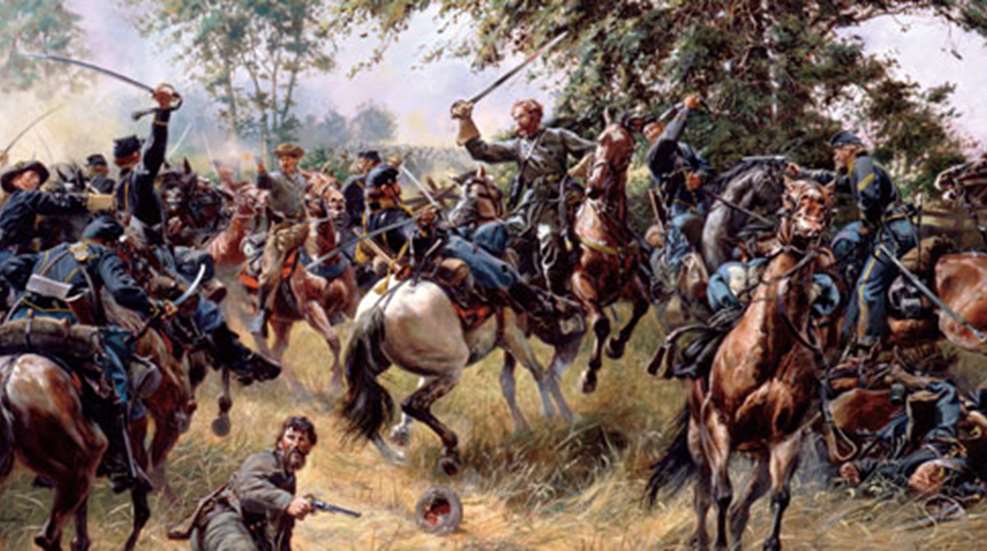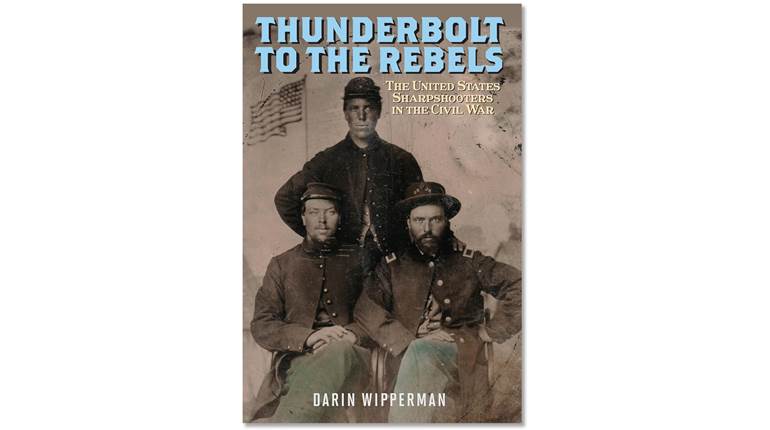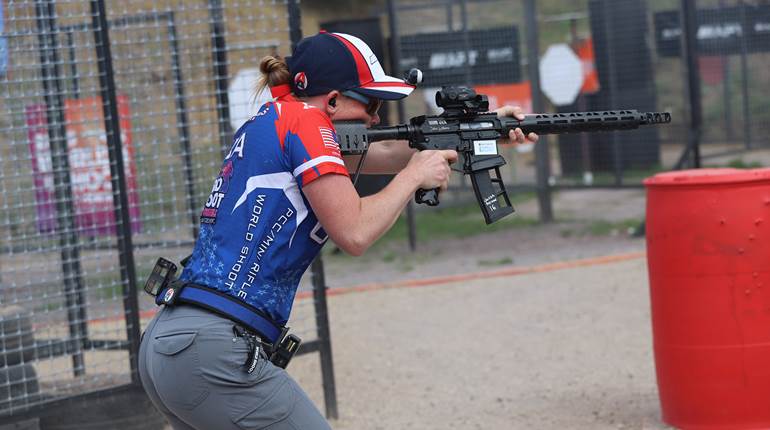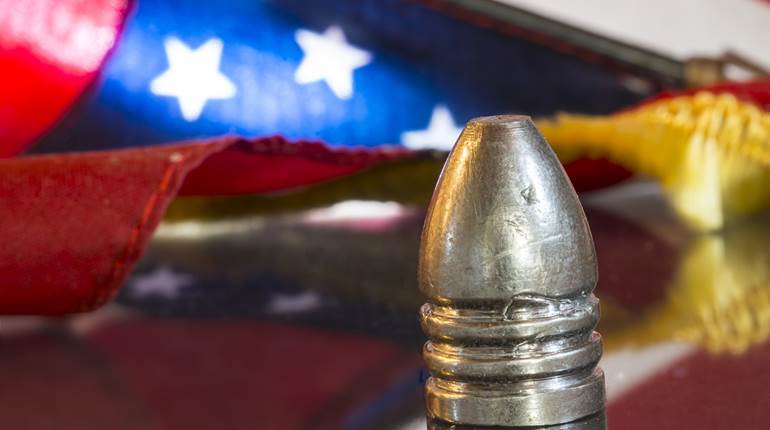
2/21/2013
One of the most controversial cavalry raids of the Civil War was the Kilpatrick-Dahlgren raid of late February 1864. The goal was to release Union prisoners being held near Richmond, Va., and the raiders arrived outside Richmond’s defenses in a blinding snowstorm. The Union cavalrymen—armed with carbines and revolvers—engaged the local militiamen. Unable to enter the city, the raiders were forced to retreat with the Southern cavalry in hot pursuit. Dahlgren’s party was ambushed and Dahlgren killed. On his person were said to be written orders to burn Richmond and kill Jeff Davis and his cabinet, orders which the Union authorities denied. Upon returning to the Union lines a report was prepared reflecting the losses of equipment, horses and men. The raid had cost the raiders 340 casualties. Among the small arms reported lost were 516 Colt .44-cal. Model 1860 revolvers, which were the primary revolvers in use by Union troops during the conflict.
By the late 1850s, the weight of Colt’s .44-cal. Dragoon revolver was found to be a major detriment to its suitability for continued military service. The Colt factory made several attempts to modify and reduce the Dragoon’s weight without success. Colt’s engineers instead concentrated their efforts on developing a new .44-cal. revolver. The gun incorporated the Model 1851 Navy’s frame, but accepted a .44-cal. rebated cylinder. The new revolvers were also equipped with a creeping, ratchet-type loading lever. These changes developed into the 2-pound, 11-ounce, single-action, six-shot .44-cal. Model 1860 percussion Colt revolver. By the early 1870s, Colt’s Hartford, Conn., plant had manufactured about 200,000 Model 1860 Colt Armys.
Model 1860 Colts, characteristically, had large brass trigger guards and blued steel backstraps. The frame, hammer and loading lever were casehardened, but the remainder of the metal parts were blued. Stocks were one-piece walnut. Early Model 1860s were stamped with “ADDRESS SAML COLT HARTFORD CT,” on the top of their barrels, although most are stamped “ADDRESS COL SAML COLT NEW YORK U.S. AMERICA.” Barrel lengths of 7 1/2 inches or 8 inches are found below serial number 3500, but most above 3500 were equipped with 8-inch barrels. Fluted cylinders are found on about 4,000 revolvers with serial numbers below 8000, and the fluted cylinders had the patent date of Sept. 10, 1850, stamped in one of the flutes. After number 8000, the rebated cylinder took its place. The rebated cylinder was rolled with the Texas Navy and Mexican battle scene, and its rear surface was equipped with six safety locking pins. The rebated cylinder was stamped “COLT PATENT NO” with the last four digits of the revolver’s serial number. The frame’s left side was stamped: “COLT/PATENT.”
A three-screw frame was standard, but many of the first 50,000 were equipped with four-screw frames to take an attachable shoulder stock, and a few of those had two-leaf folding rear sights mortised into the top of the barrels at the breech.
Colt’s first deliveries went to dealers below the Mason-Dixon line; between December 1860 and April 1861, 2,230 Model 1860s were sent south. Serial numbers on the Southern deliveries are believed to be below 3,000, and the guns were equipped with fluted cylinders. Dealers had to return some of the revolvers due to “bursting cylinders,” and the cylinders were drilled at a slight taper, increasing the supporting metal without reducing the powder capacity to solve the problem. The last 500 southern Model 1860s (serial numbers in this delivery range from 161 to 1812) were sent from the factory on April 15, 1861, to Peter Williams & Co. in Richmond, Va. Confederate forces used those revolvers and thousands captured from Union forces in their struggle for independence.
U.S. Navy Procurement And Sea Service
In May 1861, the U.S. Navy placed orders for 750 new .44-cal. Colt “New Model Holster” pistols (Model 1860s) at a cost of $25 each. The guns received were of the fluted-cylinder design, with 500 received at the Boston Navy Yard and the balance at the New York Navy Yard. The final delivery of 200 was sent to the Washington Navy Yard in August. During the inspection of the August delivery, one revolver exploded three charges at one pull of the trigger. The problem was a flaw between the chambers. The Navy exchanged several of its Model 1860 Armys for .36-cal. Model 1861s. No further Navy orders were placed for Model 1860s.
The Navy issued the .44-cal. revolvers to ships assigned to the Atlantic and Gulf blockade duty. One such ship was the sloop Oneida, which listed 40 Model 1860s on board. In 1862, Oneida saw action in passing the New Orleans forts and later at Vicksburg, Miss. On Aug. 5, 1864, the ship was damaged in the battle at Mobile Bay.
The Army had responsibility for the operations on the Mississippi River and the inland rivers until October 1862, while the Navy supplied the officers and sailors for the vessels purchased by the War Department for operations there. The Army supplied the vessels with small arms, including the Model 1860 revolvers. On Oct. 1, 1862, the Navy took over responsibility for operations on the inland waterways, and the Army gunboats and their ordnance stores were transferred to the Navy.
On the morning of July 15, 1862, the Union gunboats Tyler and Carondelet progressed up the Yazoo River near Vicksburg, Miss. About six miles up the river, they engaged the Confederate ram Arkansas, which had the advantage of iron plating. Both Union vessels were struck numerous times with 11 shells penetrating the Tyler and 13 for the Carondelet. The Arkansas suffered less damage in the battle. When it appeared that the Arkansas was about to ram the Carondelet, several sailors jumped overboard, at which time, three Colt Model 1860s and four Model 1832 Ames Foot Artillery swords were lost. The casualties for the two ships exceeded 50. The Arkansas proceeded down river and, after successfully running the entire Union fleet, she anchored at the base of the Vicksburg defenses. Arkansas’ casualties in running the Union fleet numbered 10 killed and 16 wounded.
December 12, 1862, saw the 175 officers and crew of the gunboat Cairo operating on the Yazoo River, where it was assigned to protect two gunboats trying to clear the river of torpedoes. The Confederates on shore electrically detonated two torpedoes alongside the Cairo, and she sank within 12 minutes without the loss of life. In 1964, Cairo was raised from the bottom of the river, and among the artifacts recovered from the wreck were two 1860 Colts, serial numbers 16408 and 17092. The two revolvers are on display at the U.S.S. Cairo Gunboat Museum, a portion of the Vicksburg National Military Park.
Model 1860 Colts remained on board Union warships on the western waters throughout the war. Ships known to have received them were the Mount City, Pittsburgh, Cincinnati, Cairo, Carondelet, Louisville, St. Louis, Benton, Essex, Tyler, Conestoga and Lexington. A year after the war, the Navy’s storage location at Jefferson Barracks listed 284 1860 Colts in inventory.
U.S. Army Procurement And Field Service
In May 1860, Samuel Colt wrote to the War Department requesting that his “New Model Holster” pistols, the 1860, be examined and tested, and a board of officers assembled at Washington Arsenal examined two revolvers—one with a 7 1/2-inch barrel and one with an 8-inch barrel—and tested them against a Third Model Dragoon revolver for accuracy and penetration. The board concluded its report stating: “[T]he board are satisfied that the new model revolver with the eight inch barrel will make the most superior cavalry arm we have ever had and they recommended the adoption of the new model and its issue to all mounted troops.”
The first wartime orders placed by the Army for the Model 1860 was in May 1861, totaling 1,000 “Colt’s Dragoon Pistols New Model.” By April 1862, the Colt factory had delivered more than 30,000 1860 Armys at a cost of $25 each. Further deliveries were made at reduced rates of $14.50 and $14. The last delivery was made on Nov. 10, 1863, with 800 revolvers at $14 each with bullet molds and 155 at $13.73 without. Total factory deliveries came to 127,157. Two thousand more revolvers were purchased on the open market. The Colt factory delivered to the Army an additional 1,000 1860 Colts with attachable shoulder stocks at $31 each on March 1, 1862. The March delivery was issued to the 11th New York Cavalry (Scott’s 900), which was the provost guard at Washington in 1862-1863. On the morning of Feb. 5, 1864, the Colt factory was heavily damaged by fire, which stopped production for many months. No further government orders for the Model 1860 were forthcoming.
The 1860 Colts equipped with attachable shoulder stocks were found to be of limited military utility. The 10th Kentucky Cavalry was armed with shoulder-stocked Colt .44s purchased by the state from Colt’s in the fall of 1893. In the mountainous areas of Kentucky, the enemy just stayed out of range of the 10th’s revolvers. Because of that, the 10th’s commanding officer felt they were little more than spectators, and the regiment was useless except for guard and outpost duty.
In close-range cavalry encounters, the revolver and saber were the main arms used. At Brandy Station, Va., in June 1863, the two armies faced off in the largest cavalry battle ever fought in North America. A private from the 1st Maine Cavalry captured an armed enemy cavalryman by aiming his unloaded Colt revolver at the rebel’s head. Another Maine cavalryman—after being thrown from his horse by a dismounted Confederate—drew his Colt and wounded the rebel. He approached the rebel and took his surrender.
During the July 3, 1863, cavalry battle at Gettysburg, George Custer led the 7th Michigan Cavalry in a charge against dismounted rebels as they were in the process of driving back federal skirmishers. When the 7th reached a stone wall with them on one side and the rebels on the other side, the 7th’s Colt revolvers were put to good use. With their flanks being pushed back, the 7th had to retire, and the unit’s casualties came to 100 in the action. The 7th Michigan and 1st Maine were both armed with .44-cal. Model 1860 Colts.
In November 1864, Union cavalry entered Mosby’s Confederacy (so named for partisan cavalry commander Col. John Singleton Mosby) in Northern Virginia for the purpose of destroying as much of the food stuff as possible. An eight-man detachment of the 1st New York Dragoons commanded by a sergeant was sent out to burn barns, forage and drive off livestock. They stopped at a farm house and were in the process of burning the outbuildings and barn when they were attacked by 30 of Mosby’s Cavalry. One of the dragoons shot the rebel leader with his .44-cal. Colt, but in a dash to capture one of Mosby’s men, the New Yorker’s revolver failed to fire and he in return was shot through the lungs by the Confederate. The Union cavalryman died of his wounds a few days later.
The .44-cal. Model 1860 Colts remained in field service throughout the war. At the start of the spring 1865 campaign in the East, the Army of the Potomac’s Cavalry reported 8,354 revolvers in service, which included: 4,260 .44-cal. Colts; 612 .36-cal. Colts; 257 .44-cal. Starrs; and 3,225 .44-cal. Remingtons. During that campaign, Gen. Phil Sheridan’s cavalry played a major part in forcing Gen. Lee’s surrender at Appomattox Court House on April 9, 1865. The Model 1860 Colts remained in cavalry service in the post-war period up to the adoption of the .45-cal. Colt Single Action Army revolver in 1873.





































